This year marks the 400th anniversary of the first Thanksgiving celebrated by our Pilgrim fathers and mothers in 1621.
If this fact is news to you, I’m not surprised. After all, there was very little fanfare last year to celebrate the 400th anniversary of the Pilgrims’ arrival at Plymouth, Massachusetts, in 1620, an event which President John Quincy Adams described as the “birthday” of our nation. But that seminal moment in world history passed with barely a mention.
This year, you’ll see more about the inflated price of Thanksgiving dinner than about the 400th anniversary of the holiday. And while it’s true that Bidenflation has made this year’s turkey feast the most expensive in living memory, no one who knows the true history of the first Thanksgiving can ever doubt that the Pilgrims paid a greater price for their meal than anything we ever will.
But you would have to know their story to understand that. And these days, the Pilgrims are being airbrushed out of our cultural memory.
The Pilgrims’ Progress from Heroes to Villains
The same wokesters who are busy removing Thomas Jefferson’s statue from New York City Hall have unfairly maligned our Pilgrim fathers and reframed the history of the nation they founded.
“There appear to be few commemorations, parades, or festivals to celebrate the Pilgrims this year, perhaps in part because revisionist charlatans of the radical left have lately claimed the previous year as America’s true founding,” Sen. Tom Cotton (R-AR) said last year.
The “revisionist charlatans” he was referring to are the authors of the New York Times’ “1619 Project,” which commemorates the year that the first ship arrived in the Virginia colony carrying African slaves. Recognizing the significance of the 400th anniversary of the beginning of American slavery is certainly worthwhile, but the 1619 Project’s authors went beyond recognition and sought to “reframe” all of American history around the events of 1619. For this, they have been roundly criticized by historians who decry their many inaccuracies and revisionist interpretations (including, for example, their claim that the American Revolution was fought in order to preserve slavery in the colonies).
Most of the criticism has focused on the Project’s controversial claim (which was later scrubbed from the New York Times’ website) that 1619 is the year of “our true founding,” not 1620 when the Pilgrims landed at Plymouth and planted the seed of our democracy that ripened in 1776.
In a Times op-ed rebutting the critics, Nicholas Guyatt argues that “the 1619 Project radically challenges a core narrative of American history” by refuting the notion that “the story of the United States [is] a gradual unfolding of freedom.” Instead, the Project’s authors “describe a nation in which racism is persistent and protean. White supremacy shapeshifts through the nation’s history, finding new forms to continue the work of subjugation and exclusion.”
In other words, they think Abraham Lincoln got it wrong when he said our nation was “conceived in Liberty.” They think it was conceived in racism.
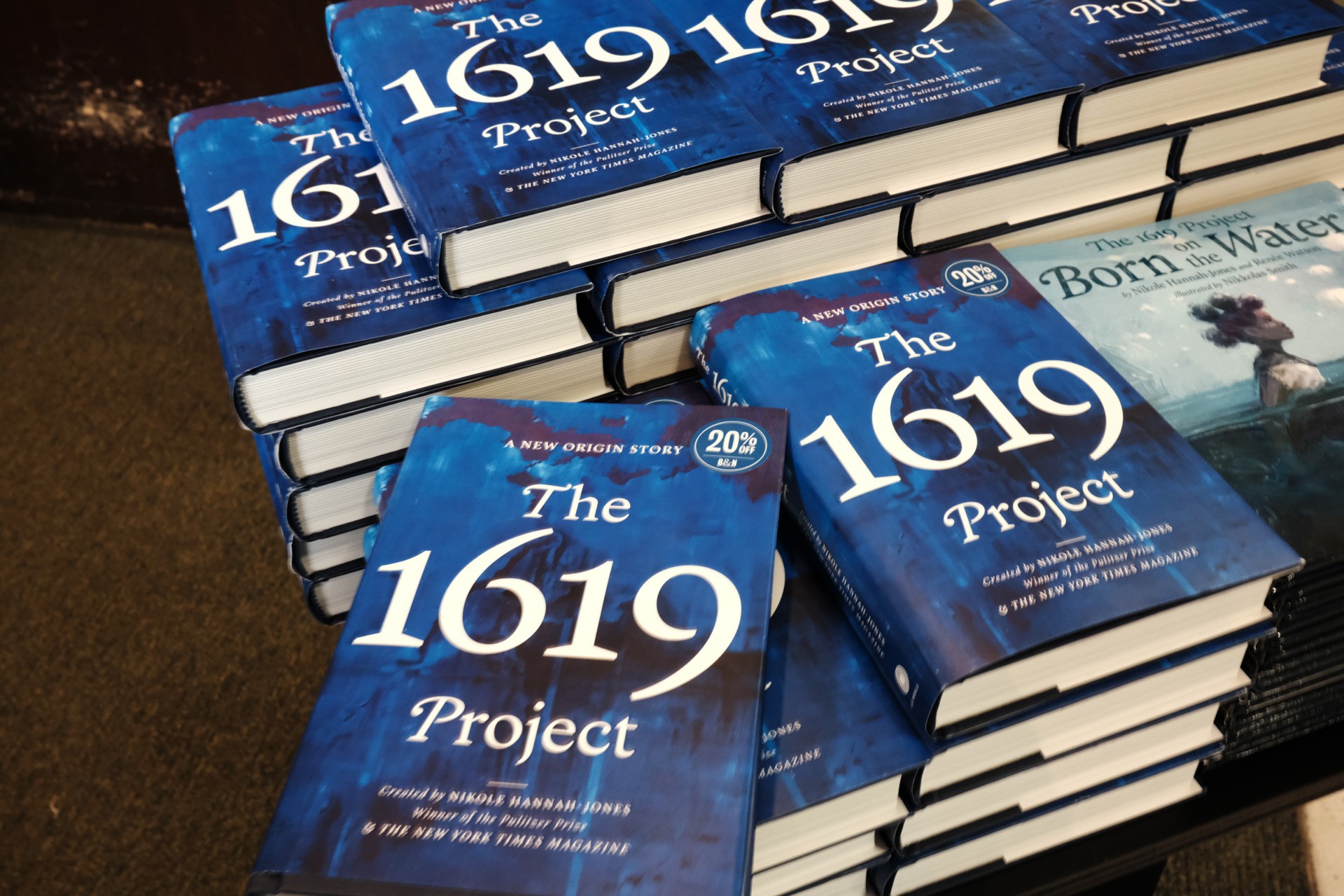
The new book by New York Times journalist Nikole Hannah-Jones, “The 1619 Project: A New Origin Story” is displayed at a New York City bookstore on November 17, 2021. (Spencer Platt/Getty Images)
And with the push to incorporate the 1619 Project and Critical Race Theory into school curriculums, these woke revisionists are hard at work rewriting our history one school kid at a time, just as they’ve been busy for years “reframing” the history of the Pilgrims and Thanksgiving.
Ann Coulter gave an excellent summary of the woke interpretation of Thanksgiving: “As every contemporary school child knows, our Pilgrim forefathers took a break from slaughtering Indigenous Peoples to invite them to dinner and infect them with smallpox, before embarking on their mission to fry the planet.”
She’s not joking. America’s teachers have “begun a slow, complex process of ‘unlearning’ the widely accepted American narrative of Thanksgiving,” according to Education Week. To unlearn the “myth” of Thanksgiving, educators are seeking ways “to help students appreciate colonial oppression of Natives and the violence that ensued from it.” The article helpfully includes a video of PBS NewsHours’ Judy Woodruff explaining that the “quintessential feel-good holiday” of Thanksgiving actually “perpetuates a myth and dishonors Native Americans.”
The story of Thanksgiving fares even worse on college campuses, where students are taught that it should be commemorated as a “National Day of Mourning,” not a day off for food, family, and football.
“It’s kind of just based off the genocide of the indigenous people,” one student at Minnesota’s Macalester College told the College Fix. “The history of the holiday is obviously not the best. It’s very violent and oppressive,” said another.
That is malicious and historically inaccurate garbage! It’s a flat out lie.
We know who the Pilgrims are and what they did because they meticulously documented their history for posterity.
Our Founding Myth
Our knowledge of the Pilgrims comes from two primary sources. The earliest account is from Edward Winslow, whose report on the founding of the Plymouth settlement was published in London in 1622, just two years after the Pilgrims arrived in the New World. The more detailed and authoritative account comes from the Pilgrims’ second governor, William Bradford, whose poignant and eloquent history Of Plymouth Plantation, written between 1630 and 1651, tells the story of the community from their formation in England to their exile in Holland and their eventual founding of the Plymouth Colony.
Any fair reading of the primary source documentation will give you all the evidence you need to understand why we chose the Pilgrims’ arrival at Plymouth as the date of “our true founding” and as the basis of our founding myth.
But before I examine that record, let me make clear what I mean by the term “founding myth.” To call an event a founding myth is not to denigrate it or to question its historical accuracy. The fact that Americans don’t understand this is an indictment of our education system, which no longer teaches the Classics (‘cuz learning Greek and Latin is apparently “racist” or something).
Our nation’s Founders understood the concept of a founding (or origin) myth in the same way the ancient Greeks and Romans did. A nation’s origin myth isn’t a falsification of history meant to deceive. Quite the contrary! It is a story rooted in history that reflects a nation’s most sacred values, rituals, and identity. To call something your founding myth is to state: This is who we were, this is who we are, and this is who we aspire to be.
An origin myth often describes the emergence of a new civilization out of the ashes of an older one.
Take, for example, the Aeneid, Virgil’s epic poem recounting the founding myth of ancient Rome. In one of the most memorable passages, Virgil provided us with a perfect reflection of the Roman concept of pietas, which means a religious and familial duty. Virgil described his hero, Aeneas, fleeing the burning city of Troy while holding the hand of his young son and carrying on his back his elderly father who is cradling in his arms their family’s household gods. In that beautiful tableau, Aeneas reflects all the values the Romans held most sacred: He is protecting his family and honoring his gods, as he flees the fall of one civilization and courageously sets out to found another, greater one in Rome.
There is a reason why we chose the Pilgrims and their establishment of the Plymouth Colony in 1620 as our origin myth, not the Virginians who settled in Jamestown over a decade before that date. Our reasoning had everything to do with the Pilgrims’ lack of racism. Americans have always aspired to be on the right side of history, and the Pilgrims were nothing if not righteous.
Their story embodies our most sacred American values. Like Aeneas fleeing the fall of Troy, the Pilgrims saw themselves as fleeing a cataclysmic conflagration about to engulf Europe. And like the Roman hero, they too hoped to forge a new civilization with a spark from the dying embers of the old one.
This is exactly how John Quincy Adams viewed the story of the Pilgrims. In a speech in 1802 commemorating the landing at Plymouth, Adams described the Pilgrims as America’s origin myth; but unlike other nations, the heroes of our founding myth were clearly known to us by their historical record, and they were defined by their virtue, not by their conquest.
“In reverting to the period of [their] origin, other nations have generally been compelled to plunge into the chaos of impenetrable antiquity, or to trace a lawless ancestry into the caverns of ravishers and robbers,” Adams told his American audience. “It is your peculiar privilege to commemorate, in this birthday of your nation, an event ascertained in its minutest details; an event of which the principal actors are known to you familiarly, as if belonging to your own age; an event of a magnitude before which imagination shrinks at the imperfection of her powers. It is your further happiness to behold, in those eminent characters, who were most conspicuous in accomplishing the settlement of your country, men upon whose virtue you can dwell with honest exultation.”
What’s more, Adams explained that the Pilgrims were the antithesis of cruel or racist conquers seeking to vanquish and plunder. Instead, they “were illustrious by their intrepid valor no less than by their Christian graces … Their glory has not been wafted over oceans of blood to the remotest regions of the earth. They have not erected to themselves colossal statues upon pedestals of human bones, to provoke and insult the tardy hand of heavenly retribution. But theirs was ‘the better fortitude of patience and heroic martyrdom.’ Theirs was the gentle temper of Christian kindness; the rigorous observance of reciprocal justice; the unconquerable soul of conscious integrity.”
Who were these heroes who engendered such praise?
And why should this small group of English settlers be revered by Americans today who aren’t directly descended from them?
After all, unlike John Quincy Adams, I have no personal family connection to the Pilgrims. My family didn’t arrive on the Mayflower in 1620. They came from Lebanon on an ocean liner in 1913.
So why should Americans — diverse as we are today — call these English settlers our “Pilgrim Fathers and Mothers”? Why should we feel a kinship to them as if we were their children, when most of us don’t have a drop of their blood in our veins?
Let me tell you their story in their own words. You will see that we are all their children — whether we arrived on these shores in 1619, 1913, or were here all along.
And you will see why we chose their arrival as the date of “our true founding” and why that decision says everything about our progress as a nation.
Their story tells us who we were, who we are, and who we aspire to be.
Saints and Strangers
The Pilgrims were devout Christians, and much like evangelical Christians today, these Englishmen and women sought to live by a simpler Biblical-based faith modeled after the early church of the Apostles.
They wanted to live as a community that worshipped and worked together, but England and its established Church enacted laws that forbade religious gatherings in private houses. These laws basically thwarted the Pilgrims’ ability to practice their faith as a community. So, in 1608, faced with the threat of imprisonment for their faith, the small community fled England and settled in Holland, which was known as a refuge for Protestant dissenters.
But after living a decade among the Dutch, they realized it was time to leave the Old World altogether. In 1618, Europe was on the cusp of one of the most violent periods in its history. The conflict, which became known as the Thirty Years War, would pit Protestant and Catholic European powers against each other. For the Pilgrims, the impending cataclysm seemed like the beginning of Armageddon. They felt the best course of action was to leave the Old World behind and try to establish some holy remnant in the new one.
Getting there was the hard part. The small community was not wealthy. They were humble working class folks. They were pious husbands and wives with children seeking a place where they could worship in peace, not adventurers seeking treasure and conquest on behalf of a monarch. Nevertheless, the congregation pooled its resources and obtained a land patent from the Plymouth Company to settle in an area at the northernmost tip of the Virginia Company’s colony. They would eventually receive financing from London bankers who offered to back their venture with the understanding that the Pilgrims would repay these debts with their labors in the New World.
A merchant vessel called the Mayflower was charted for them, but the London financiers made it clear that the Pilgrims were not going to be the only passengers. The investors insisted that a rag tag crew of non-religious settlers—who the Pilgrims referred to as “the Strangers”—were also coming along for the ride, and that would soon become a source of awkwardness. But that was the least of their worries, really.
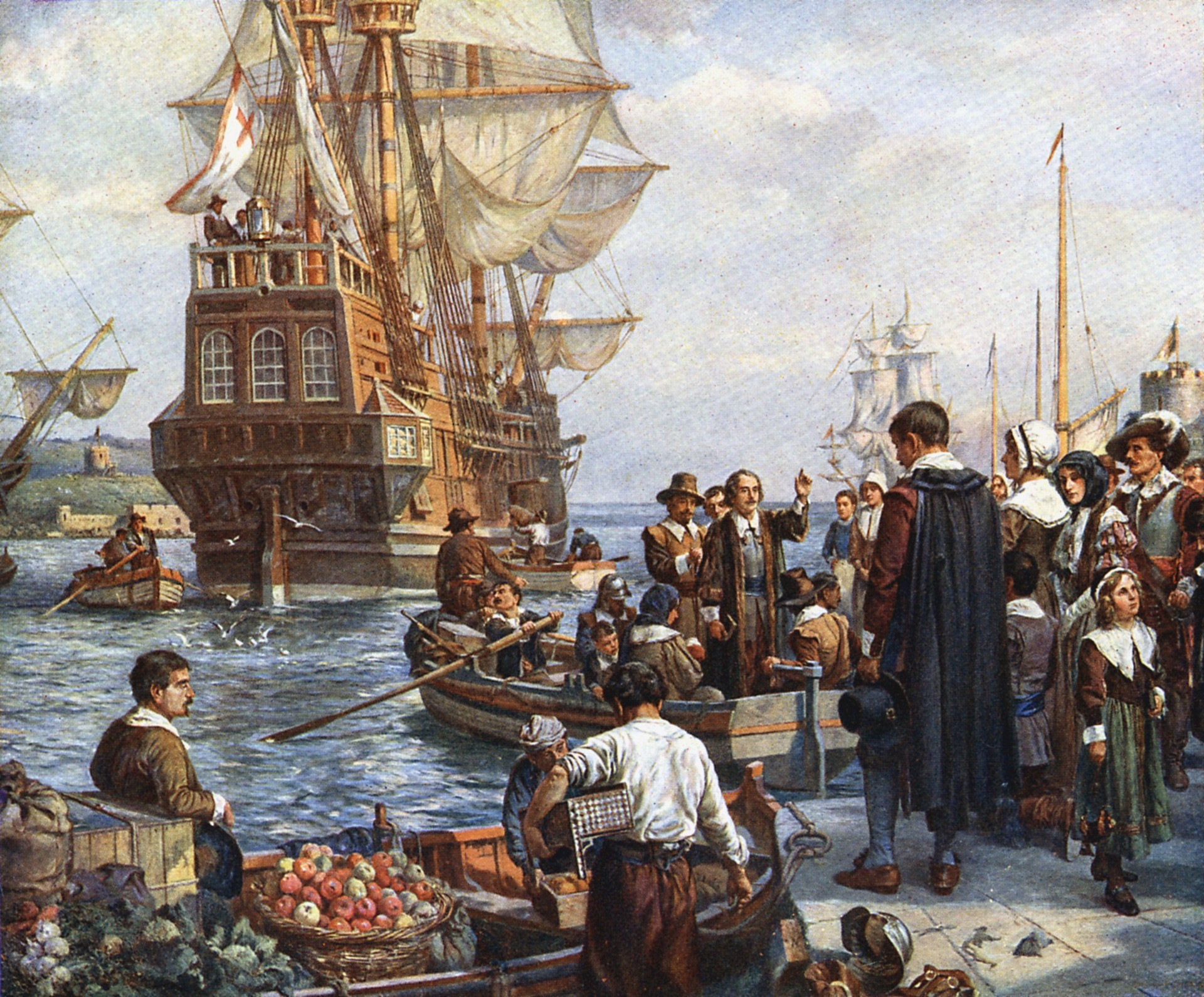
Pilgrim Fathers boarding the Mayflower for their voyage to America, painting by Bernard Gribble. (Ann Ronan Pictures/Print Collector/Getty Images)
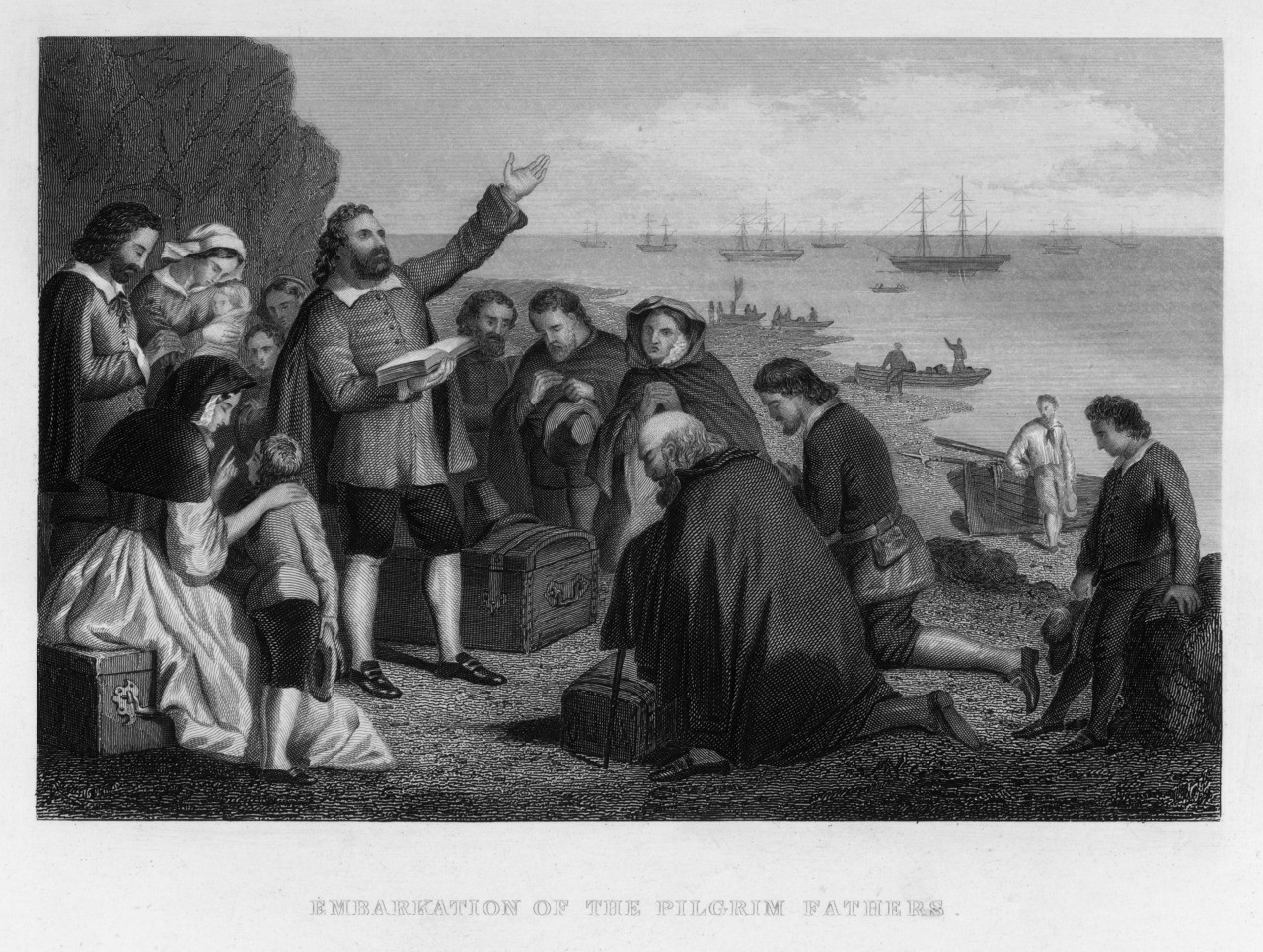
The “Embarkation of the Pilgrim Fathers” from England in September 1620, as they commence their journey on the Mayflower to the New World. (Archive Photos/Getty Images)
By the time the Mayflower left Plymouth, England, on September 6, 1620, with 102 passengers onboard, they were setting sail way too late in the year for a successful journey. Trans-Atlantic sea voyages were a frightening and often fatal endeavor. It was comparable to going to the Moon or Mars. Even the best crossing was perilous, and that would be in springtime when the weather was more moderate. To set out in September meant they were arriving in winter … But wait, it got worse…
After 65 days—and two deaths—at sea, the Mayflower made landfall on November 9, 1620.
“Having found a good haven and being brought safely in sight of land, they fell upon their knees and blessed the God of Heaven who had brought them over the vast and furious ocean, and delivered them from all the perils and miseries of it, again to set their feet upon the firm and stable earth, their proper element,” Bradford wrote of that moment.
But the jubilation was short lived. They soon discovered they were over 200 miles off-course. They were nowhere near Virginia. And what’s worse, it was almost winter—in Massachusetts.
“Having thus passed the vast ocean, and that sea of troubles,” the Pilgrims “had no friends to welcome them, nor inns to entertain and refresh their weather-beaten bodies, nor houses — much less towns — to repair to,” Bradford wrote:
As for the season, it was winter, and those who have experienced the winters of the country know them to be sharp and severe, and subject to fierce storms, when it is dangerous to travel to known places, — much more to search an unknown coast. Besides, what could they see but a desolate wilderness, full of wild beasts and wild men; and what multitude there might be of them they knew not!
…Summer being done, all things turned upon them a weather-beaten face; and the whole country, full of woods and thickets, presented a wild and savage view.
So, why didn’t they just turn around and head south for Virginia? Because the Mayflower’s captain told them that he couldn’t spare any more provisions. He needed to keep stores saved for his own return voyage to England. So, they had to shove off and muddle onshore as best they could because he wasn’t hanging around forever, and if they didn’t get a-move on he might just dump them onshore and abandon them to the elements before they even had time to build a shelter.
Again, Bradford, writing in third person, explained the situation the Pilgrims found themselves in:
If they looked behind them, there was the mighty ocean which they had passed, and was now a gulf separating them from all civilized parts of the world. If it be said that they had their ship to turn to, it is true; but what did they hear daily from the captain and crew? That they should quickly look out for a place with their shallop, where they would be not far off; for the season was such that the captain would not approach nearer to the shore till a harbour had been discovered which he could enter safely; and that the food was being consumed apace, but he must and would keep sufficient for the return voyage. It was even muttered by some of the crew that if they did not find a place in time, they would turn them and their goods ashore and leave them.
The Kernel of Our Democracy
A new conflict arose before they could even get started. They had no governing agreement binding them. Their charter was for Virginia, not wherever this place was.
The “Strangers”—who weren’t especially civil or pious—felt no allegiance to the Pilgrims or to each other. They figured it was every man for himself. But with winter setting in and with dangerously few provisions to speak of, the Pilgrims knew that if they didn’t all stick together, they would all die.
Edward Winslow explained what happened next:
This day before we came to harbor, observing some not well affected to unity and concord, but gave some appearance of faction, it was thought good there should be an association and agreement that we should combine together in one body, and to submit to such government and governors as we should by common consent agree to make and choose, and set our hands to this that follows word for word.
Thus, they wrote out and signed what became known as the Mayflower Compact, the first governing document of the Plymouth Colony—and the first document to establish self-governance in the New World.
Here are the words:
IN THE NAME OF GOD, AMEN. We, whose names are underwritten, the Loyal Subjects of our dread Sovereign Lord King James, by the Grace of God, of Great Britain, France, and Ireland, King, Defender of the Faith, &c. Having undertaken for the Glory of God, and Advancement of the Christian Faith, and the Honour of our King and Country, a Voyage to plant the first Colony in the northern Parts of Virginia; Do by these Presents, solemnly and mutually, in the Presence of God and one another, covenant and combine ourselves together into a civil Body Politick, for our better Ordering and Preservation, and Furtherance of the Ends aforesaid: And by Virtue hereof do enact, constitute, and frame, such just and equal Laws, Ordinances, Acts, Constitutions, and Officers, from time to time, as shall be thought most meet and convenient for the general Good of the Colony; unto which we promise all due Submission and Obedience. IN WITNESS whereof we have hereunto subscribed our names at Cape-Cod the eleventh of November, in the Reign of our Sovereign Lord King James, of England, France, and Ireland, the eighteenth, and of Scotland the fifty-fourth, Anno Domini; 1620
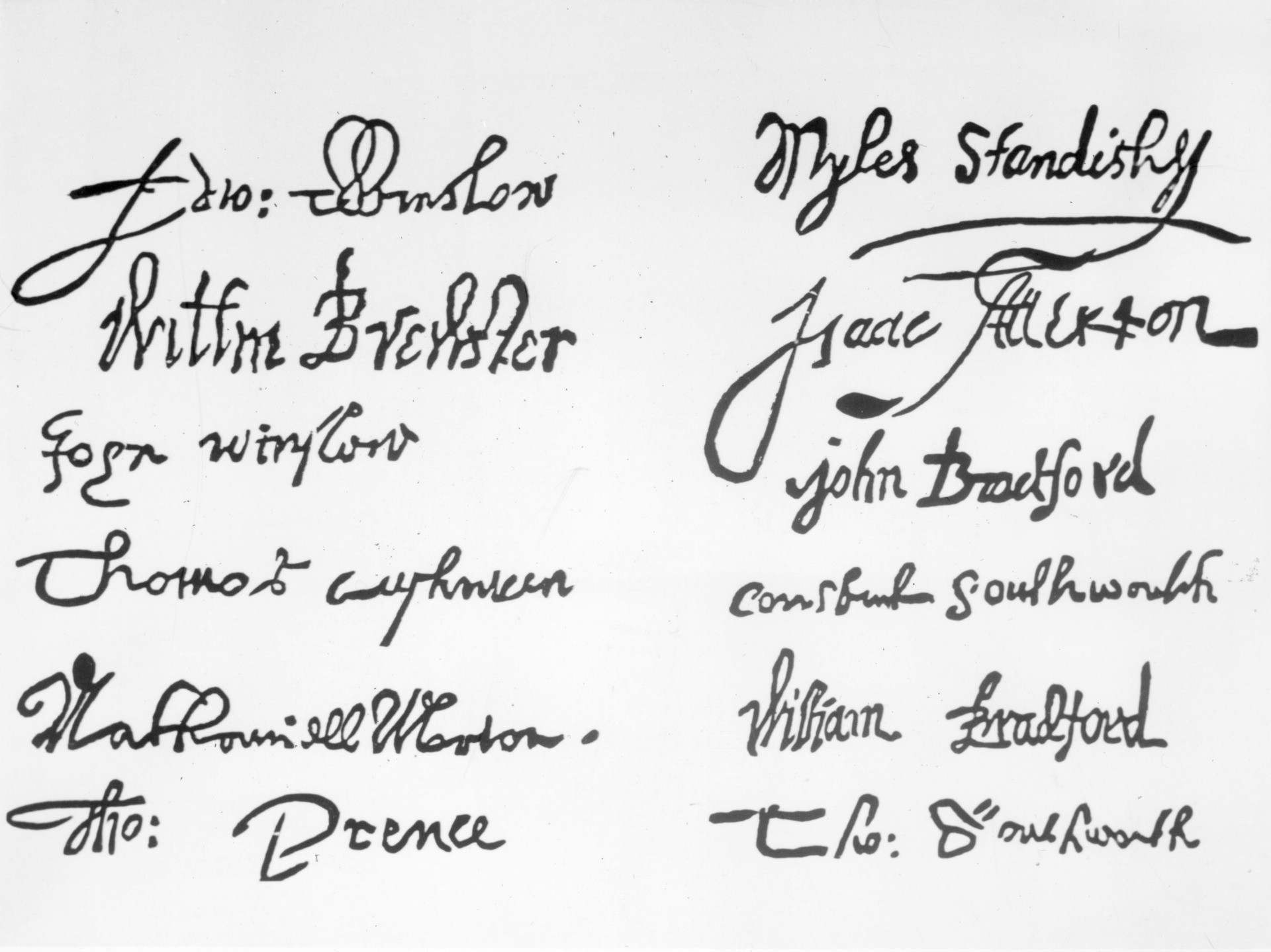
The signatures on the Mayflower Compact, including William Brewster, William Bradford, Myles Standish, and Edward Winslow. (Three Lions/Hulton Archive/Getty Images)
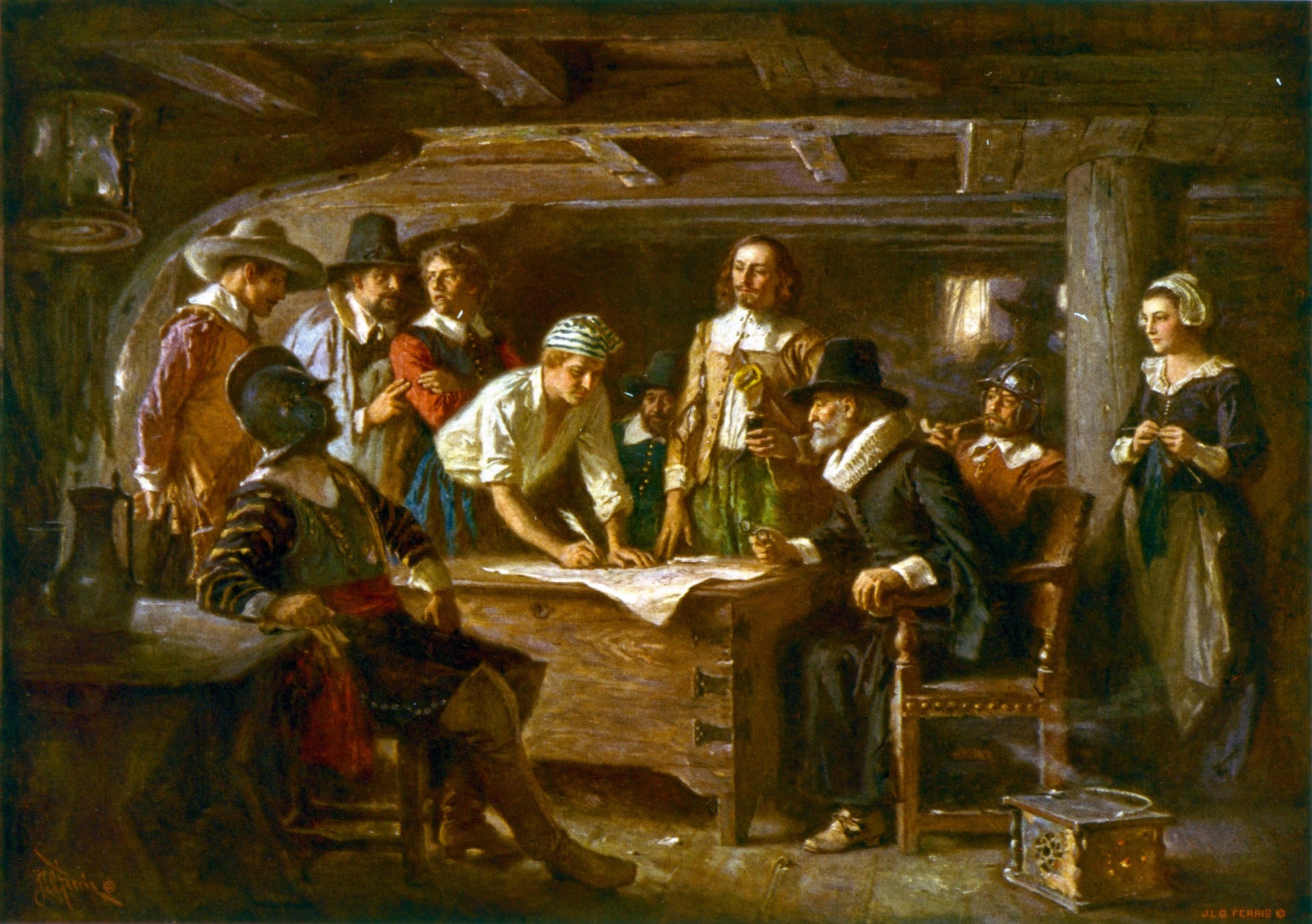
The Signing of the Mayflower Compact in 1620, painting by Jean Leon Gerome Ferris (Wikimedia Commons)
It was clear to them that the only thing binding them to this governing document was their own consent to be governed by it.
“What they did was enact social compact theory that had been sort of kicked around in Europe, especially in Britain, for a while,” University of Oklahoma historian and author Professor Wilfred McClay told Breitbart News. “They created a body politic out of the consent of those who were aboard the ship, and they had the foresight to realize they should and could do that.”
The Mayflower Compact wasn’t an elaborate political and legal charter establishing a system of government, like our Constitution. Nor was it a treatise establishing a governing philosophy, like our Declaration of Independence. It was little more than a paragraph. But within that paragraph we have the kernel of our democracy.
This true historical event, taking place nearly two centuries before the signing of the Declaration of Independence, embodied a fundamental American value: the belief that government is based on the consent of the governed.
Our First Dark Winter
Having signed a governing agreement, the Plymouth settlers then elected their first governor, John Carver. During their first forays ashore, the settlers discovered that the area was largely desolate.
In the years prior to their arrival, the population of the local Indian tribes had been decimated by civil wars and by a plague brought by European fisherman. The disease had wiped out whole villages, where the settlers found only scattered bones, left to the elements because no one survived to bury them.
They decided to build their settlement on the ruins of an abandoned Indian village called Patuxet, where once as many as 2,000 Indians had lived before the plague ravaged the area.
So, finally on December 18, 1620, with the Mayflower anchored a mile offshore, the Pilgrims came ashore in the bitter cold, with rain and sleet pouring down on them, to build their settlement.

The Pilgrim Fathers coming ashore for the first time at Plymouth. (Hulton Archive/Getty Images)
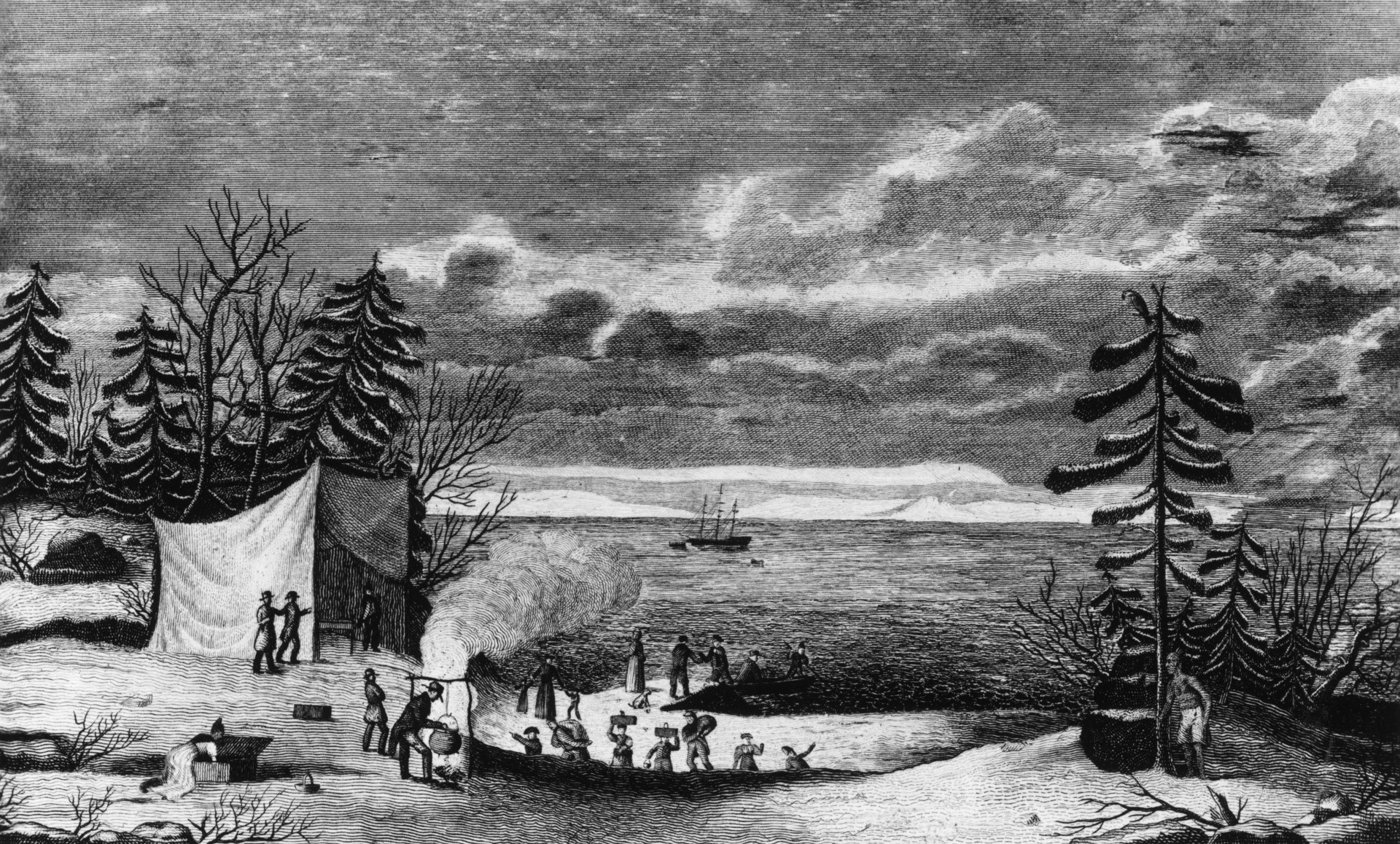
The Pilgrims make camp at Plymouth Colony in December of 1620, as the Mayflower lies anchored in the bay and a Native American watches furtively from the trees. (MPI/Getty Images)
Is it any wonder that they lost over half their numbers that winter?
They were ill-equipped. The weather was impossible. Many of them didn’t even leave the Mayflower, and eventually the ship was turned into a makeshift hospital for the sick and dying. Those who settled in the village lived in constant fear of being attacked by hostile Indian tribes.
During the course of the winter months, so many members of the Plymouth Colony died that they were afraid to bury their dead lest the Indians realize how thinned out their numbers had become. At one point, they propped up the corpses against the trees surrounding the settlement and placed muskets in their arms to disguise the dead to look like sentries guarding the perimeter of the colony.
By the time March came around, the settlers were barely holding on, but the captain and crew of the Mayflower were ready to leave for the return voyage to England. This was a make-or-break moment for the Plymouth Colony. Would they survive on their own with their last tie to England gone and no hope of return?
Samoset and Squanto
At that providential moment, an Indian named Samoset of the Wampanoag Tribe walked into the Plymouth camp and astonished the Pilgrims by greeting them in English, which he had learned from interacting with various contingents from the Virginia Colony.
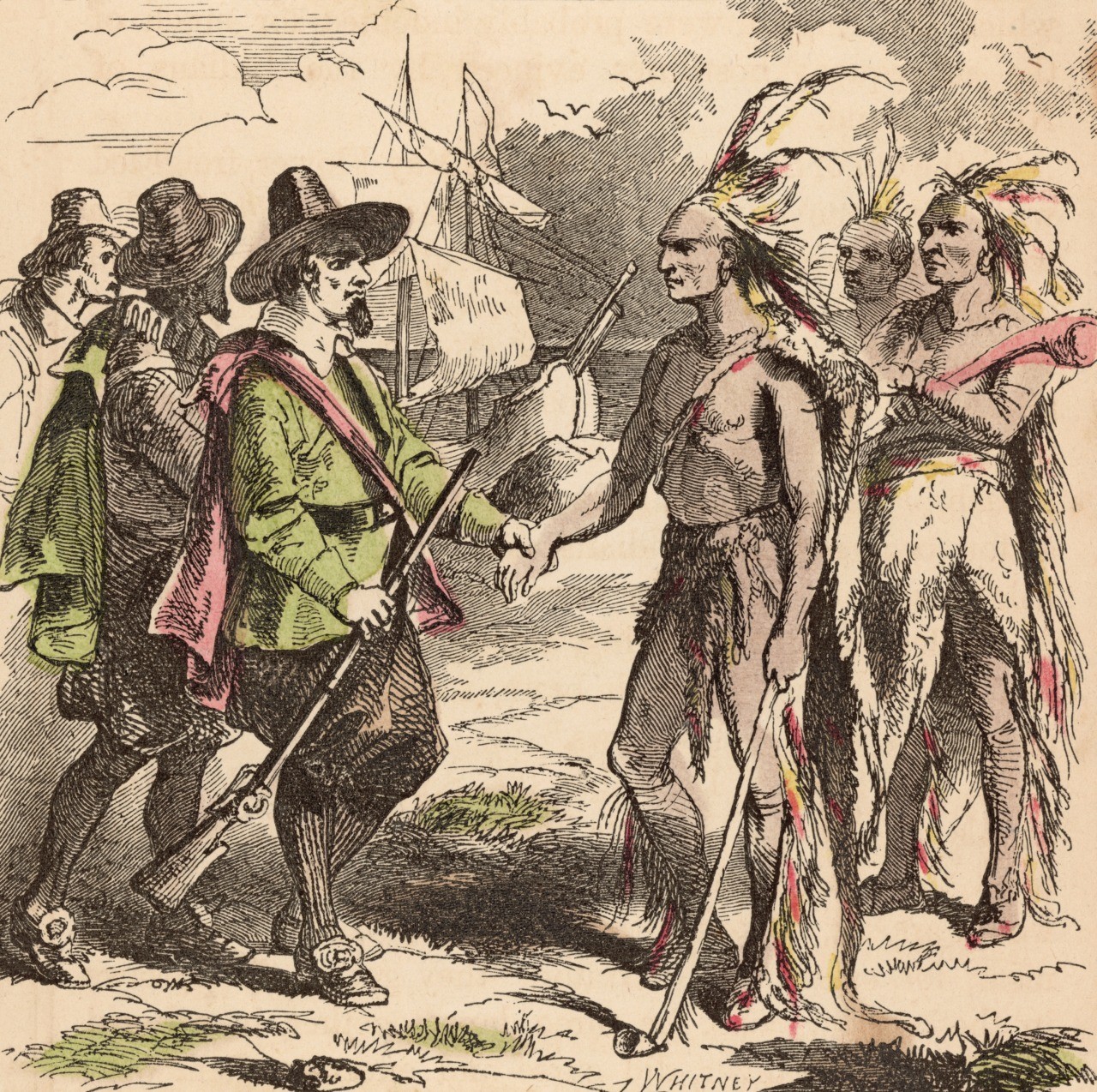
Samoset of the Wampanoag Tribe entered the Plymouth settlement and called out a greeting of ‘Welcome’ in English. (Archive Photos/Getty Images)
The settlers learned from Samoset that this area was the Wampanoag Tribe’s territory, but the tribe had been so weakened by the plague that their leader, Massasoit, felt increasingly at the mercy of enemy tribes, who also happened to be the same ones menacing the Pilgrims.
As Winslow recounted:
[Samoset] discoursed of the whole country, and of every province, and of their sagamores, and their number of men, and strength. The wind being to rise a little, we cast a horseman’s coat about him, for he was stark naked, only a leather about his waist, with a fringe about a span long, or little more; he had a bow and two arrows, the one headed, and the other unheaded. He was a tall straight man, the hair of his head black, long behind, only short before, none on his face at all; he asked some beer, but we gave him strong water and biscuit, and butter, and cheese, and pudding, and a piece of mallard, all which he liked well, and had been acquainted with such amongst the English. He told us the place where we now live is called Patuxet, and that about four years ago all the inhabitants died of an extraordinary plague, and there is neither man, woman, nor child remaining, as indeed we have found none, so as there is none to hinder our possession, or to lay claim unto it.
Six days later, Samoset returned to the village with the Wampanoag leader Massasoit. After entertaining their visitors with food and sport, the Pilgrims and the Wampanoags negotiated a mutually beneficial agreement. They would defend each other in the event of an attack by the hostile tribes. And later on, they would establish trade with each other. To help the settlers survive the next winter, an Indian by the name of Tisquantum, or Squanto, stayed with the settlers to show them how to plant their spring crops.
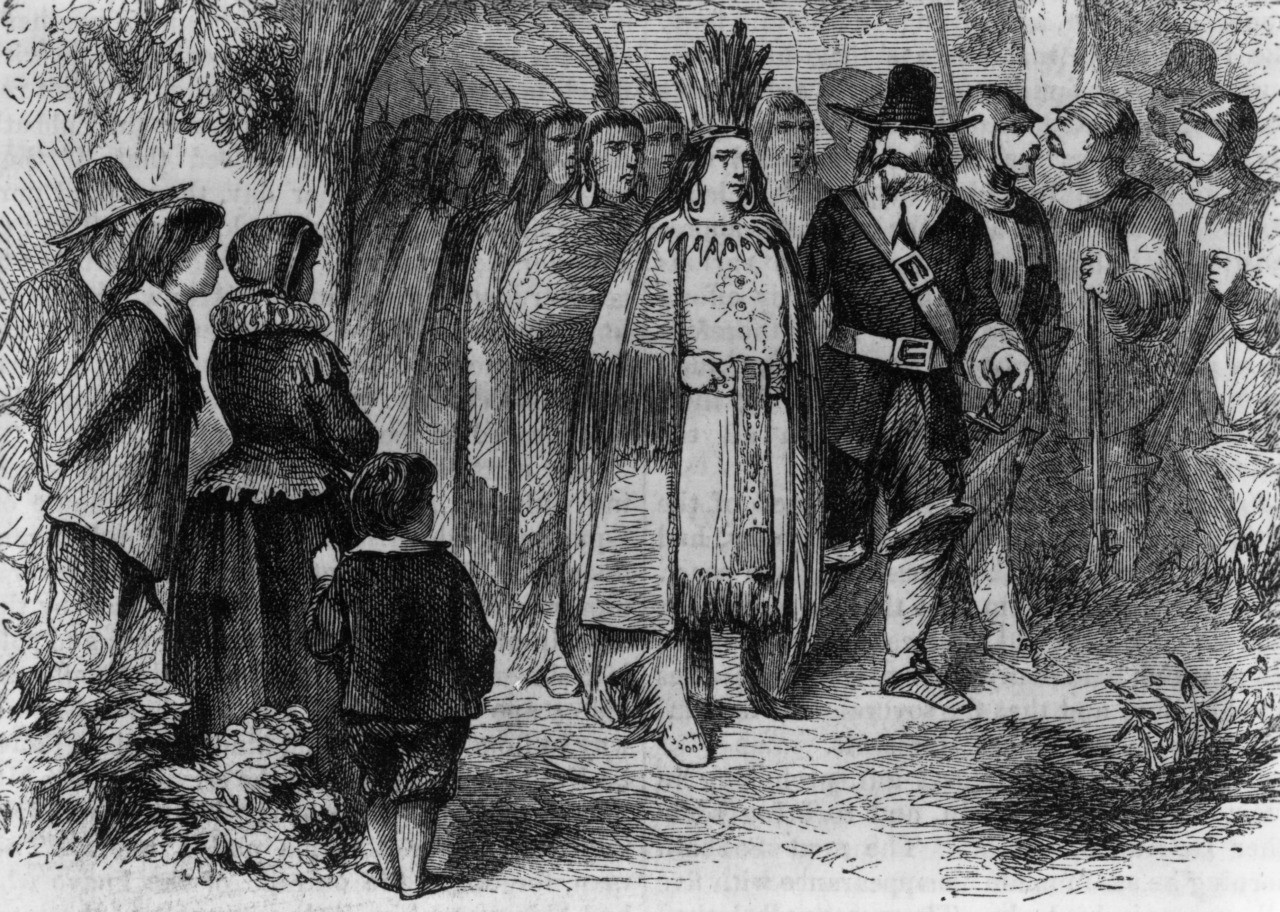
Circa 1621, Massasoit, chief of the Wampanoag Tribe, pays a friendly visit to the Pilgrims’ camp at Plymouth Colony with his warriors, after signing the earliest recorded treaty in New England with Governor John Carver. (MPI/Getty Images)
Massachusetts and Virginia
Squanto’s story offers us a good opportunity to explain the difference between the Plymouth and Virginia colonies.
Squanto spoke English because in 1614, six years before the Pilgrims arrived, an expedition from the Virginia Colony led by Captain John Smith (of Pocahontas fame) charted the area around Cape Cod and Massachusetts Bay.
One of the commanders with Smith, a man named Thomas Hunt, decided to make extra money by kidnapping Indians and selling them into slavery. Squanto was among the victims Hunt trafficked to England, which is how he learned English. He eventually regained his freedom after his final captor, an English explorer named John Dermer, died during an expedition to the Wampanoag territory.
The tragic irony is that, had Squanto not been taken against his will across the ocean, he would have died with the rest of his village when Patuxet was wiped out by the plague. You see, Squanto was the sole survivor of the Patuxets—the people whose deserted village the Pilgrims had built their settlement upon.
And yet this man, who had so many reasons to curse the English, worked side by side with the Pilgrims that spring of 1621, showing them how to plant crops and assisting them in establishing trade with the surrounding tribes. Without his help, the Plymouth Colony would have failed.

Squanto (aka Tisquantum) of the Patuxet Tribe pointing out a coastal rock while serving as guide and interpreter for the Pilgrims. (Kean Collection/Getty Images)
From their encounters with Squanto and the other Indians, the men and women of Plymouth came to respect the Native people and feel shame for the treatment they had endured at the hands of other Englishmen.
Historian Nathaniel Philbrick explains one encounter:
At Cummaquid they encountered disturbing evidence that all was not forgotten on Cape Cod when it came to past English injustices in the region. An ancient woman, whom they judged to be a hundred years old, made a point of seeking out the Pilgrims “because she never saw English.” As soon as she set eyes on them, she burst into tears, “weeping and crying excessively.” They learned that three of her sons had been captured seven years before by Thomas Hunt, and she still mourned their loss. “We told them we were sorry that any Englishman should give them that offense,” Winslow wrote, “that Hunt was a bad man, and that all the English that heard of it condemned him for the same.”
And that was just one tale of the atrocities committed by European explorers before the Pilgrims even arrived in the New World. In fact, even before hearing these tales, the Pilgrims were distrustful of the attitude of the other English settlers.
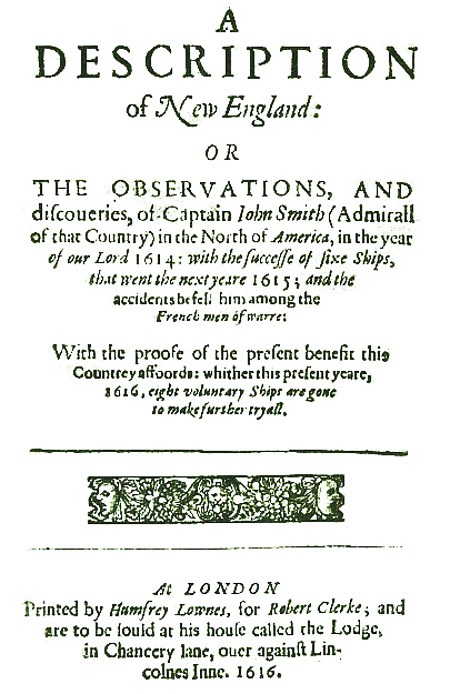
The title page of John Smith’s account his exploration of New England, published in 1616.
Before they left England, the Pilgrims were looking for a military commander for their settlement. By far the most qualified man for the job was Captain John Smith (again, of Pocahontas fame). No one knew the whole region better than Smith. He literally drew the map of it. But the Pilgrims didn’t like him. They found him arrogant and too worldly and figured they could just make do with his maps without hiring the map-maker.
The dislike was mutual; Smith despised the Pilgrim’s piety and later mocked their refusal to hire him. He would dismissively describe them as “humorists” (meaning religious fanatics) and would write that the Pilgrims refused “to have any knowledge by any but themselves, pretending only religion their governor and frugality their counsel.” And he meant that as an insult!
Smith was right that the Pilgrims could have saved themselves a lot of grief if they had hired someone who knew where he was going. But in the end, the Pilgrims survived thanks to their fortitude, the grace of God, and the help of their new friends.
And, yes, they did indeed regard the Indians as their friends. As Winslow recounted that year, “We have found the Indians very faithful in their covenant of peace with us; very loving and ready to pleasure us; we often go to them, and they come to us.”
Far from being judgmental or superior to them, the Pilgrim Winslow described their Native allies as “a people without any religion or knowledge of God, yet very trusty, quick of apprehension, ripe-witted, just.”
Nearly two centuries later, John Quincy Adams would state that “no European settlement ever formed upon this continent has been more distinguished for undeviating kindness and equity toward” the Native Americans than the Pilgrims at Plymouth.
And that brings us to the Thanksgiving story.
Our First — and Most Expensive — Thanksgiving
With the help of Squanto, the Pilgrims had a successful harvest in the fall of 1621. They had come through the first winter, after losing 60 percent of their group. But rather than mourn the 60 percent lost, they rejoiced that 40 percent still lived and gave thanks to God.
Bradford wrote:
They began now to gather in the small harvest they had, and to fit up their houses and dwellings against winter, being all well recovered in health and strength and had all things in good plenty. For as some were thus employed in affairs abroad, others were exercised in fishing, about cod and bass and other fish, of which they took good store, of which every family had their portion. All the summer there was no want; and now began to come in store of fowl, as winter approached, of which this place did abound when they came first (but afterward decreased by degrees). And besides waterfowl there was great store of wild turkeys, of which they took many, besides venison, etc. Besides, they had about a peck of meal a week to a person, or now since harvest, Indian corn to that proportion.
The famous Thanksgiving harvest feast that we’ve come to cherish is from Winslow:
Our harvest being gotten in, our governor sent four men on fowling, that so we might after have a special manner rejoice together after we had gathered the fruit of our labors; they four in one day killed as much fowl, as with a little help beside, served the company almost a week, at which time amongst other recreations, we exercised our arms, many of the Indians coming amongst us, and among the rest their greatest King Massasoit, with some ninety men, whom for three days we entertained and feasted, and they went out and killed five deer, which they brought to the plantation and bestowed on our governor, and upon the captain, and others. And although it be not always so plentiful as it was at this time with us, yet by the goodness of God, we are so far from want that we often wish you partakers of our plenty.
And there you have it! The Pilgrims gathered for a harvest feast, and the Wampanoags joined them and brought venison to add to the feast, which lasted for three days and included sports (no word on whether it was football).
Let the record show that this first Thanksgiving actually was a “quintessential feel-good holiday.”
And considering how much it cost them in death, suffering, and toil to get to that celebration, I think it’s fair to say that this first Thanksgiving was, in fact, the most expensive in our history.
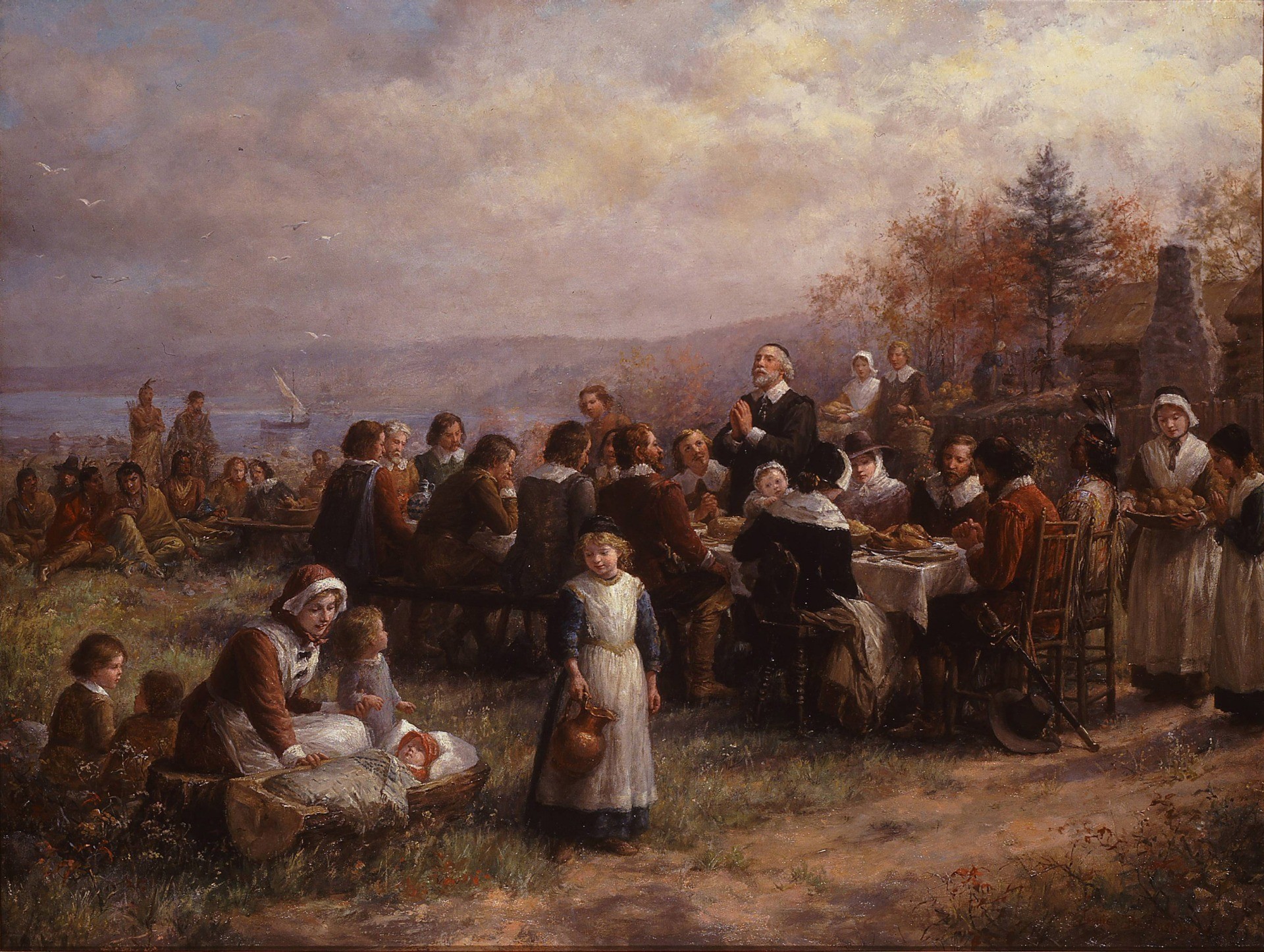
Thanksgiving at Plymouth, painting by Jennie Augusta Brownscombe, 1925 (National Museum of Women in the Arts)
Why Lincoln Chose 1620 to Rebuke 1619
So why did Abraham Lincoln choose to make this account of Thanksgiving a national holiday in 1863?
Our origin myth was still a matter of some debate up until that time. Throughout the early nineteenth century, Americans hotly debated whether the nation’s founding should be celebrated as the Jamestown Colony in Virginia or the Plymouth Colony in Massachusetts. The decision to favor Plymouth was helped along by the rediscovery of Bradford’s beautiful diary, Of Plymouth Plantation.
Bradford’s manuscript had disappeared from the New World in 1777 when the last royal governor of the colony took it from the Old South Church in Boston and carted it across the Atlantic to England. He probably meant this as a final insult to the patriotic New Englanders who were reviled by the British as traitors and brigands fomenting rebellion.
For nearly a century Bradford’s manuscript was lost to Americans, until one Boston scholar happened to see a passage in another book quoting Bradford’s journal. He eventually discovered that the manuscript had been housed all that time in the library of the Bishop of London. (Yes, the irony — the Pilgrim Bradford’s journal was being held by a bishop of the very Church that forced Bradford’s persecuted community to flee from England.)
For decades, the Brits refused to return the manuscript to its proper owners in the United States. (They really know how to hold a grudge.)
But in 1856 the British allowed a special edition of Bradford’s journal to be published, and that inspired a renewed appreciation for the Pilgrims and their history.
The publication came right at a time when our nation was on the cusp of a great conflagration—as bloody and catastrophic for us as the war that caused the Pilgrims to flee Europe. It was a fight over our most basic and sacred values: the right of all men—not just Englishmen—to live in freedom and enjoy the fruits of self-governance.
So, is it any wonder that in the midst of the bloodiest year of our Civil War—just one month before he delivered his Gettysburg Address—Abraham Lincoln decided once and for all that our nation’s founding should harken to Plymouth, not Virginia?
Of course, Lincoln chose to honor the ancestors of the New England abolitionists, not the rebellious slaveowners of Virginia.
On October 3, 1863, our 16th president declared that Thanksgiving would be commemorated as a national holiday every year on the last week in November in honor of the Pilgrim fathers.
In this sense, Lincoln chose the events of 1620 as our true founding in order to repudiate the events of 1619.
We chose the Pilgrims as our founding myth because they embodied our most cherished ideals. They were the best of us.
They endured despite the odds; and through trial and error, they established the principles of self-governance, private property, a common defense, and peaceful commerce as a means of coexistence. They even established the practice of religious tolerance and pluralism with the “Strangers” among them, who became friends.
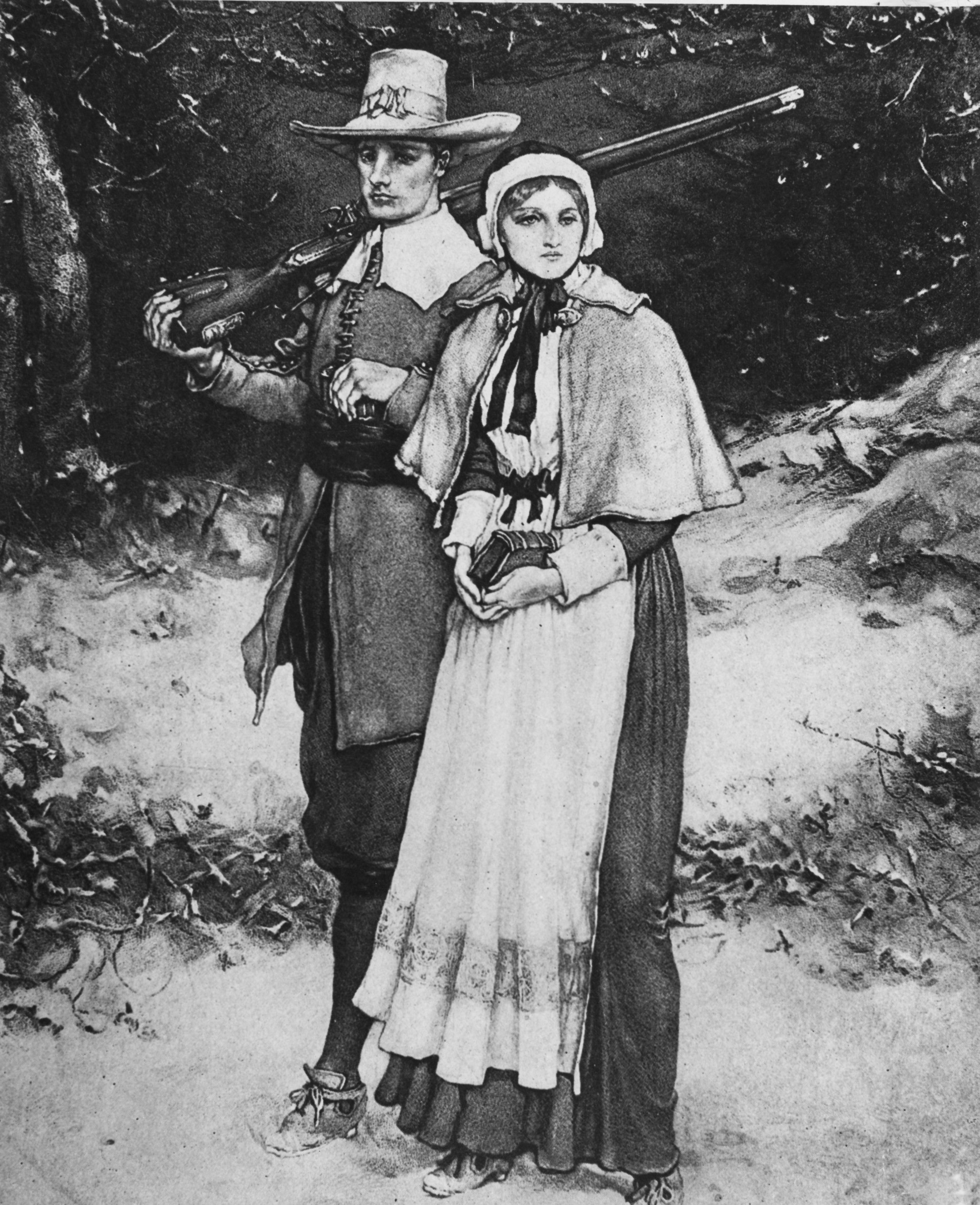
John Alden with his wife, Priscilla, at the Plymouth Colony. Alden is said to be the first person from the Mayflower to set foot on Plymouth Rock in 1620. Painting by George H. Boughton. (Frederic Lewis/Archive Photos/Getty Images)
What’s more, the decision to embrace the Pilgrims as our true founders was made at a time when Americans were most keenly aware of the scourge of slavery because they were fighting a bloody civil war to eradicate it. These Americans understood that slavery was not just a moral blight; it was a deadly contradiction that we couldn’t live with and still pretend to uphold the self-evident truth that all men are created equal. The generation that suffered the most to abolish slavery chose the Pilgrims as our founders because the Pilgrims embodied the ideals that inspired them to free the slaves. They wanted us to know that our nation was founded on God-given freedom, not racism.
This sentiment was made clear in the speech Massachusetts Gov. Roger Wolcott delivered in 1897 at the official ceremony to accept the return of Bradford’s manuscript by England to its rightful owners in America.
The Plymouth settlement was “the birthplace of religious liberty, the cradle of a free Commonwealth,” Wolcott said:
In the varied tapestry which pictures our national life, the richest spots are those where gleam the golden threads of conscience, courage, and faith, set in the web by that little band [of Pilgrims]. May God in His mercy grant that the moral impulse which founded this nation may never cease to control its destiny; that no act of any future generation may put in peril the fundamental principles on which it is based — of equal rights in a free state, equal privileges in a free church, and equal opportunities in a free school.
Equal rights, equal privileges, equal opportunities – that is what Americans have always aspired to uphold. Conscience, courage, faith – that is what the Pilgrims stood for and what they prayed their descendants would stand for.
To honor the founding of Plymouth in 1620 is not to ignore the horrific history of American slavery that began in 1619 in Virginia. And to celebrate Thanksgiving is not to dismiss the atrocities committed against our Native communities, even sadly at the hands of the Pilgrims’ descendants. On Thanksgiving, we acknowledge that the Pilgrims and the Natives did, in fact, come together in peace in November 1621.
We celebrate their story—and the ritual reenactment of it with a turkey feast and prayers of thanksgiving—to acknowledge our highest aspirations, not to whitewash our history or minimize our mistakes. Thanksgiving affirms who we want to be because it commemorates who the Pilgrims actually were.
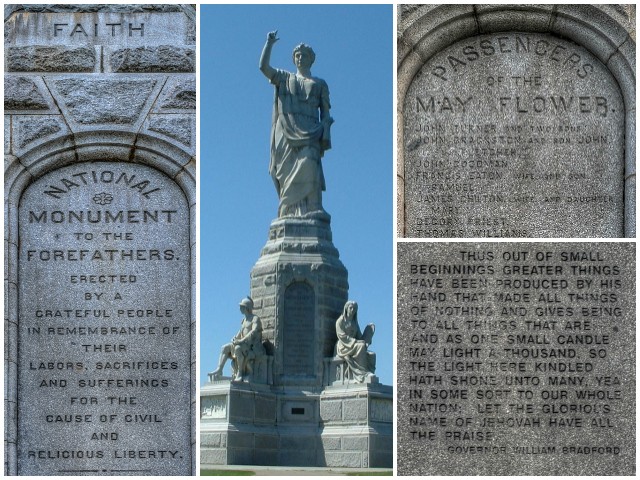
The National Monument to the Forefathers in Plymouth, Massachusetts. The 81-foot-tall statue (center) was dedicated in 1889. The monument’s inscriptions include a dedication panel (left), a list of the Mayflower passengers (top right), and an inscription from William Bradford’s manuscript (bottom right). (Wikimedia Commons)
“There is a kind of audacity about these people,” Professor McClay told Breitbart News. “The journeys were dangerous. The habitats into which they were coming were brutal. They lost many lives, and yet they had this sense—and [the Puritan leader John] Winthrop says it in his sermon—that they were on a mission from God, that ‘the eyes of all people are upon us’—which, when you think about it, this is like somebody going to the Moon—the dark side of the Moon—and saying, ‘The eyes of all people are upon us.’ Well, actually you’re on the Moon. Nobody’s watching! And yet they were so deeply committed to the vision of what they were doing, and that was the germ of what became ultimately a great nation.”
Actually, they knew that God was watching and all the future generations of their children.
And, yes, we are all their children.
In Of Plymouth Plantation, Bradford described the fateful moment when the Pilgrims realized that they had landed in an unsettled area and there was no way to turn back:
What, then, could now sustain them but the spirit of God, and His grace? Ought not the children of their fathers rightly to say: Our fathers were Englishmen who came over the great ocean, and were ready to perish in this wilderness; but they cried unto the Lord, and He heard their voice, and looked on their adversity.
… Let them therefore praise the Lord, because He is good, and His mercies endure forever. Yea, let them that have been redeemed of the Lord, show how He hath delivered them from the hand of the oppressor. When they wandered forth into the desert-wilderness, out of the way, and found no city to dwell in, both hungry and thirsty, their soul was overwhelmed in them. Let them confess before the Lord His loving kindness, and His wonderful works before the sons of men!
Amen. And Happy Thanksgiving on this 400th anniversary.
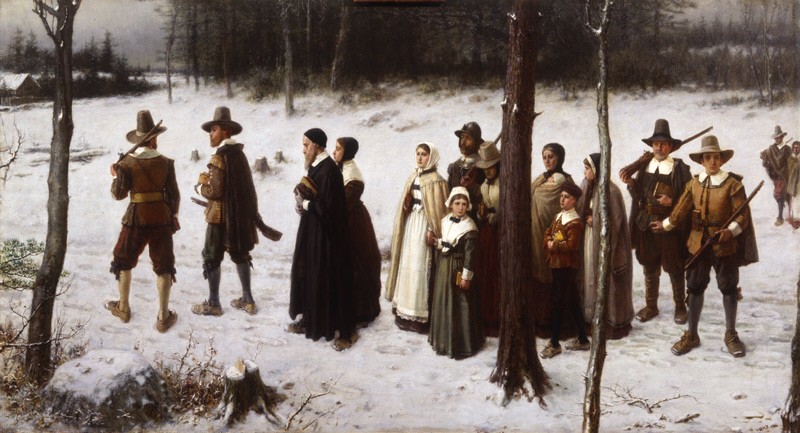
Pilgrims Going to Church, painting by George Henry Boughton (New York Historical Society)
Rebecca Mansour is Senior Editor-at-Large for Breitbart News. Follow her on Twitter at @RAMansour.
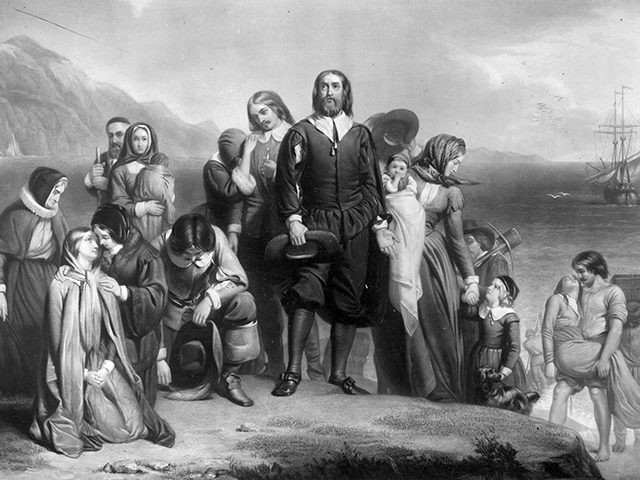
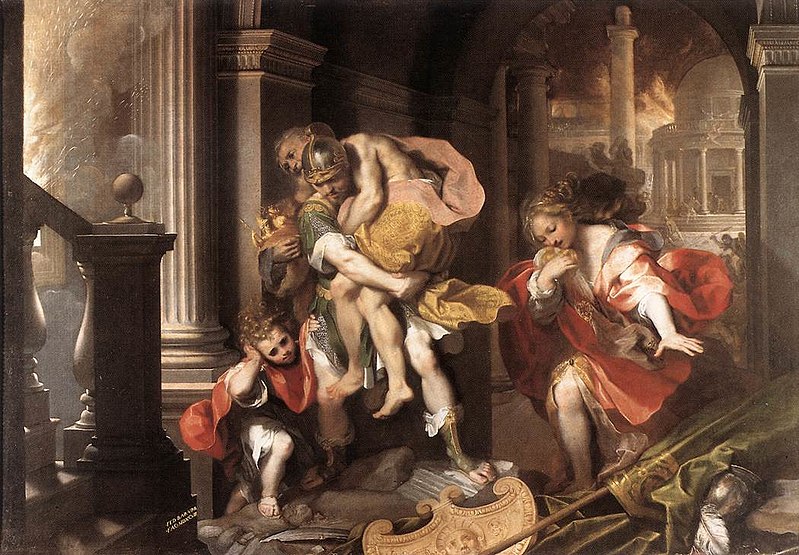
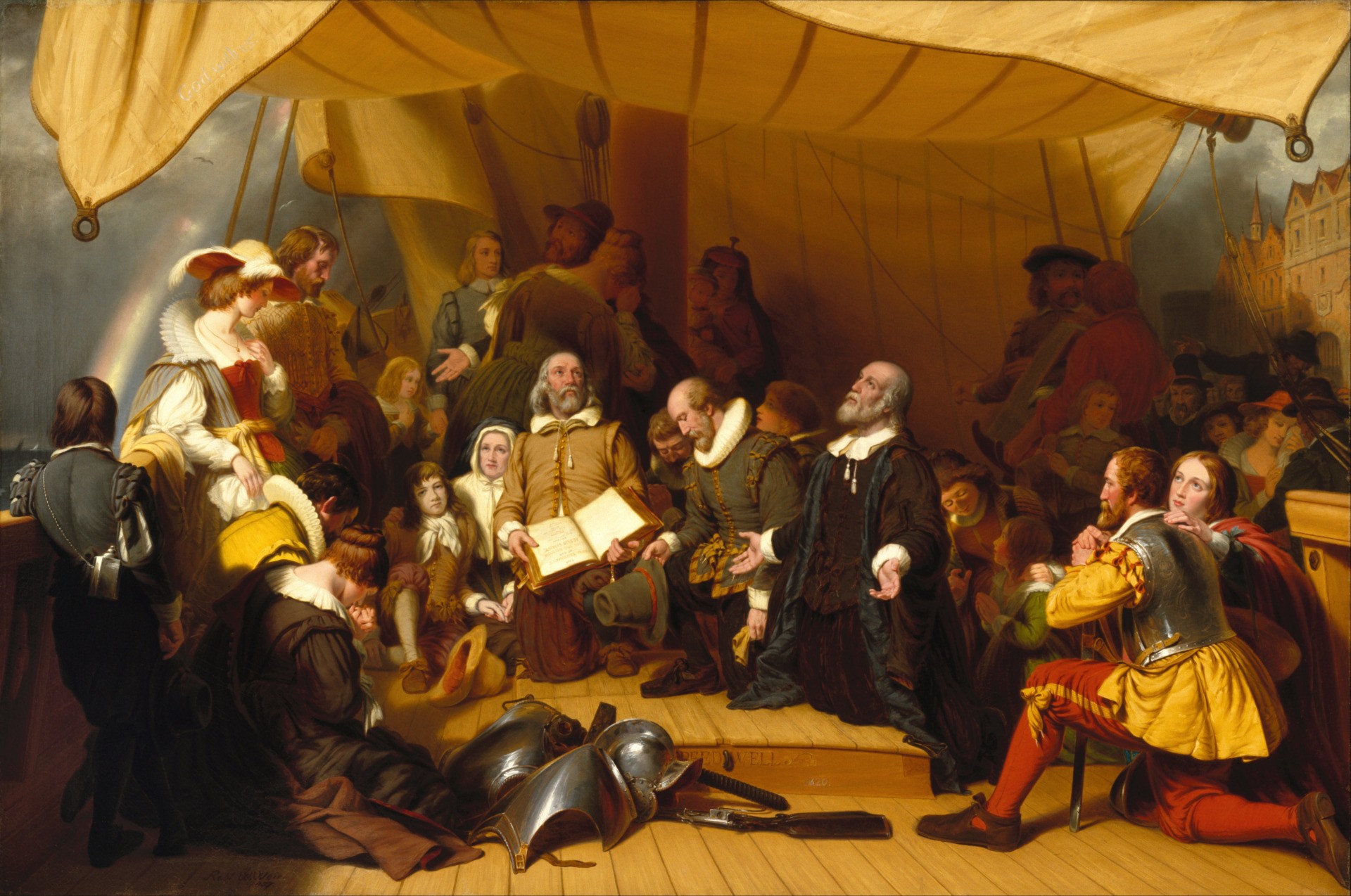
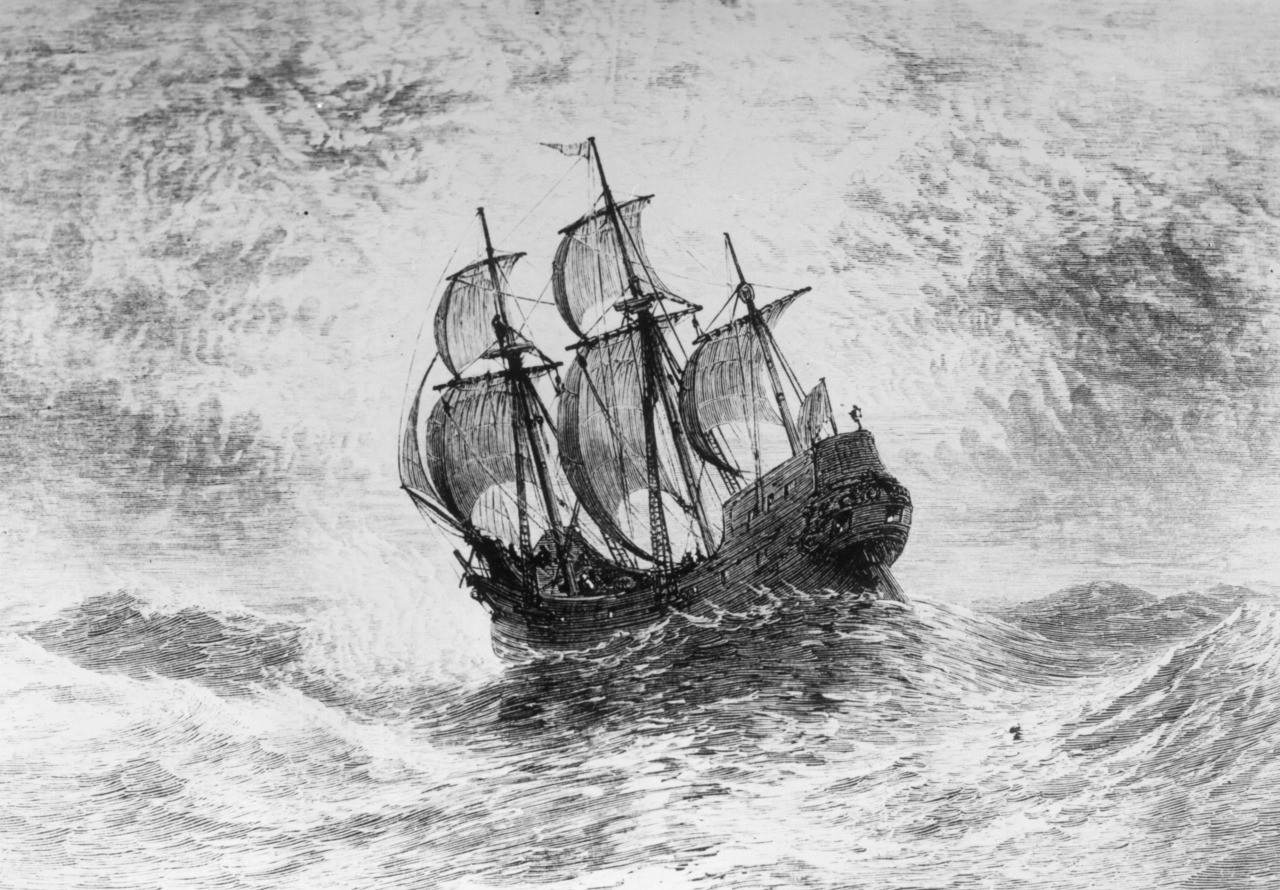
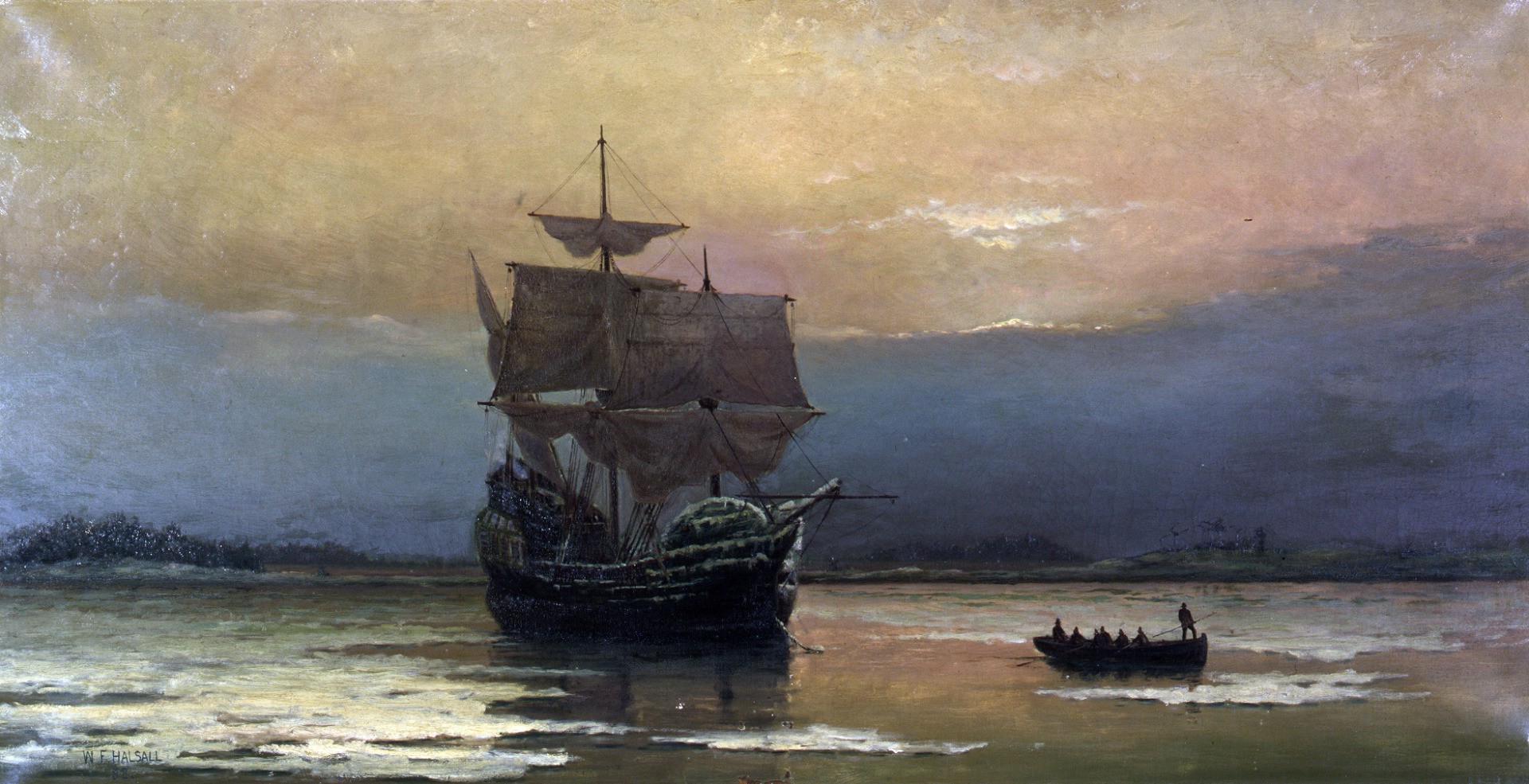
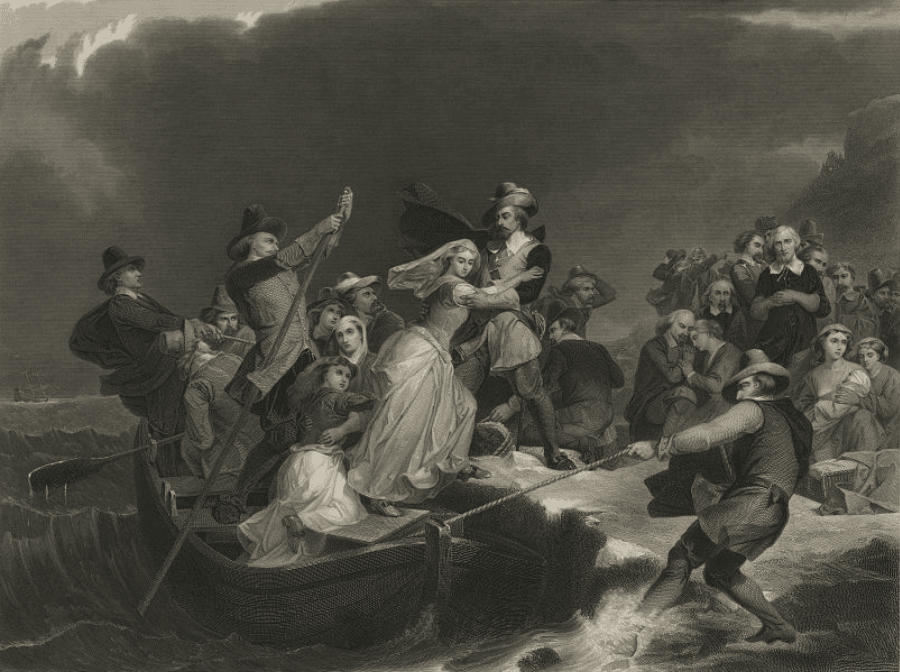
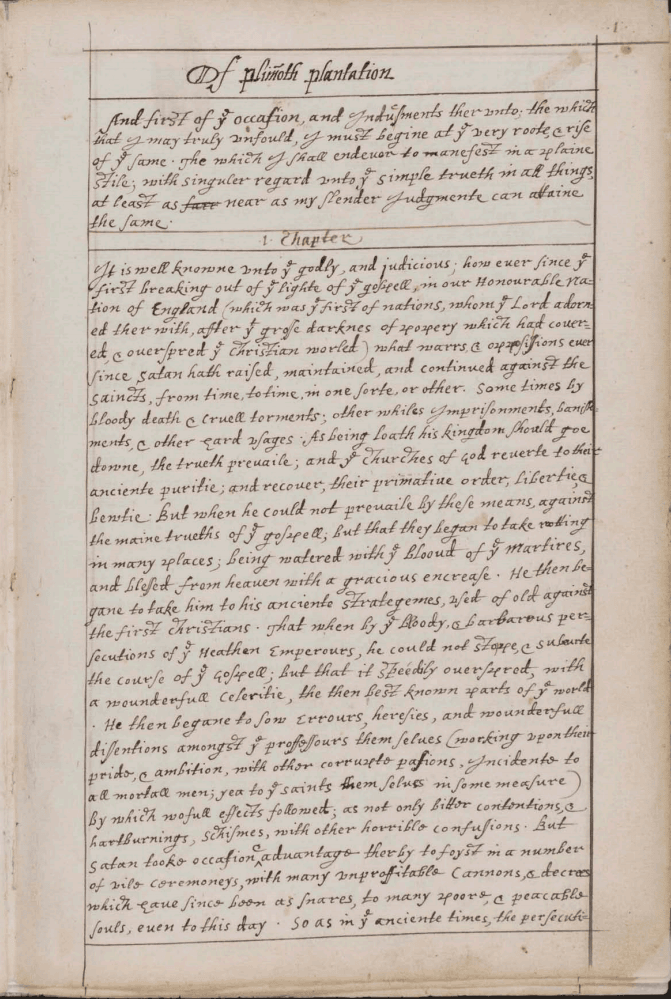
COMMENTS
Please let us know if you're having issues with commenting.